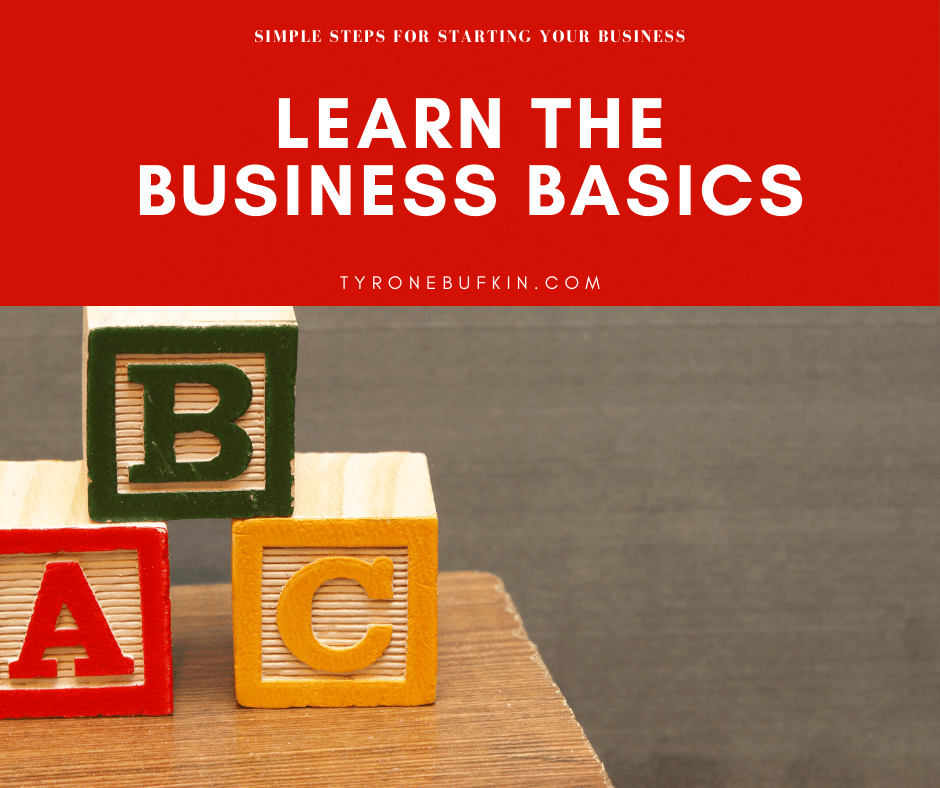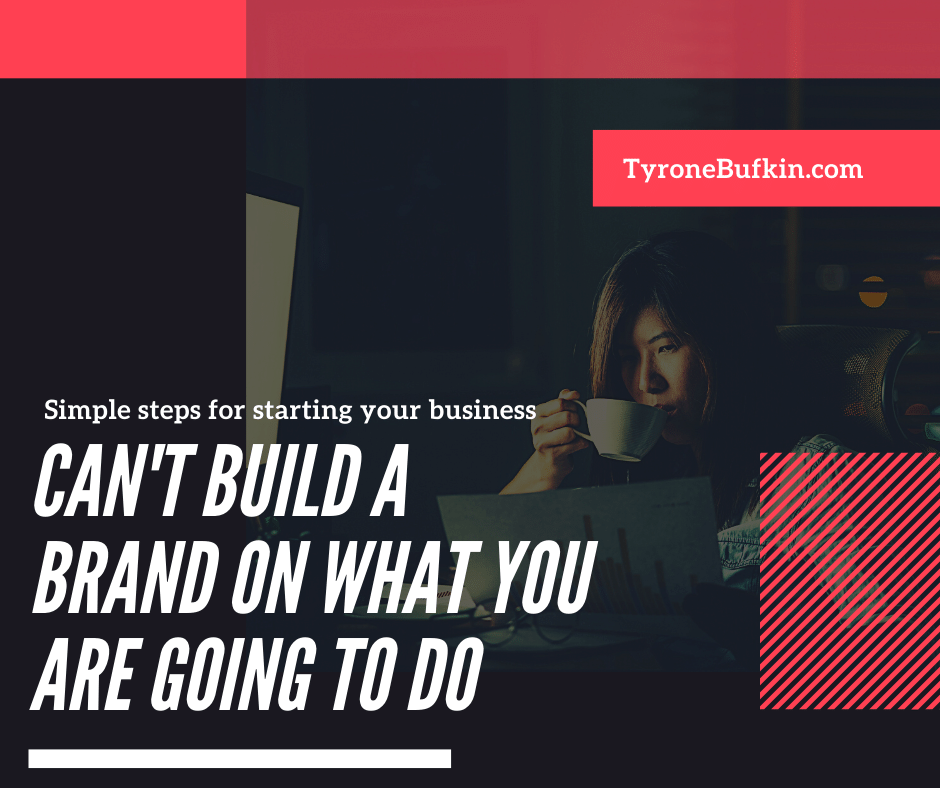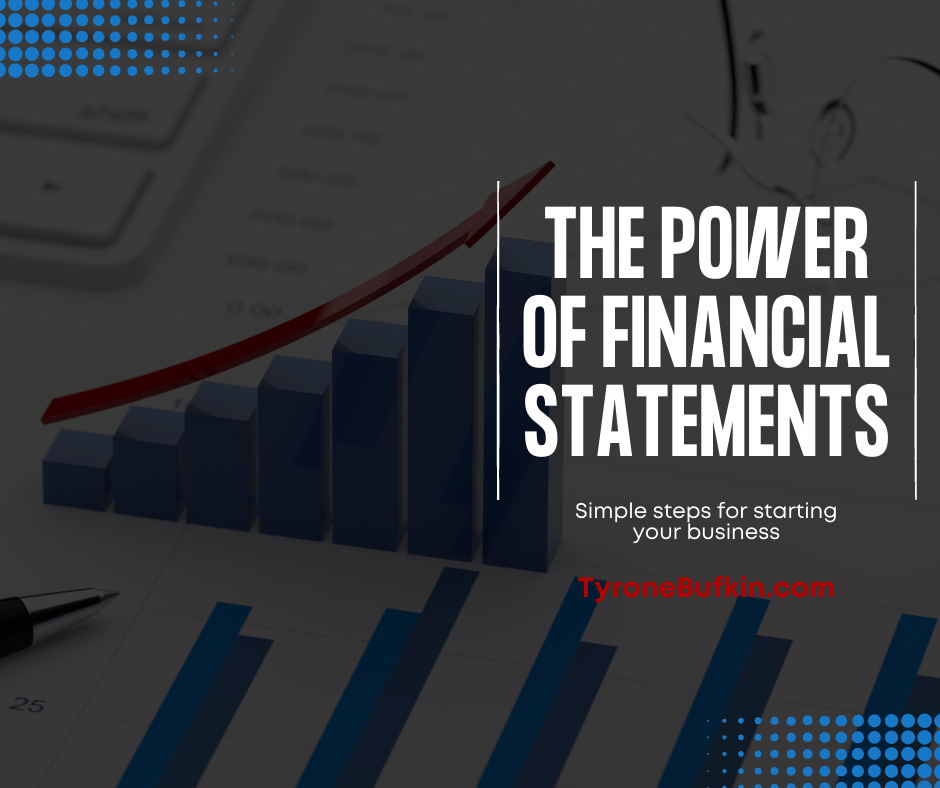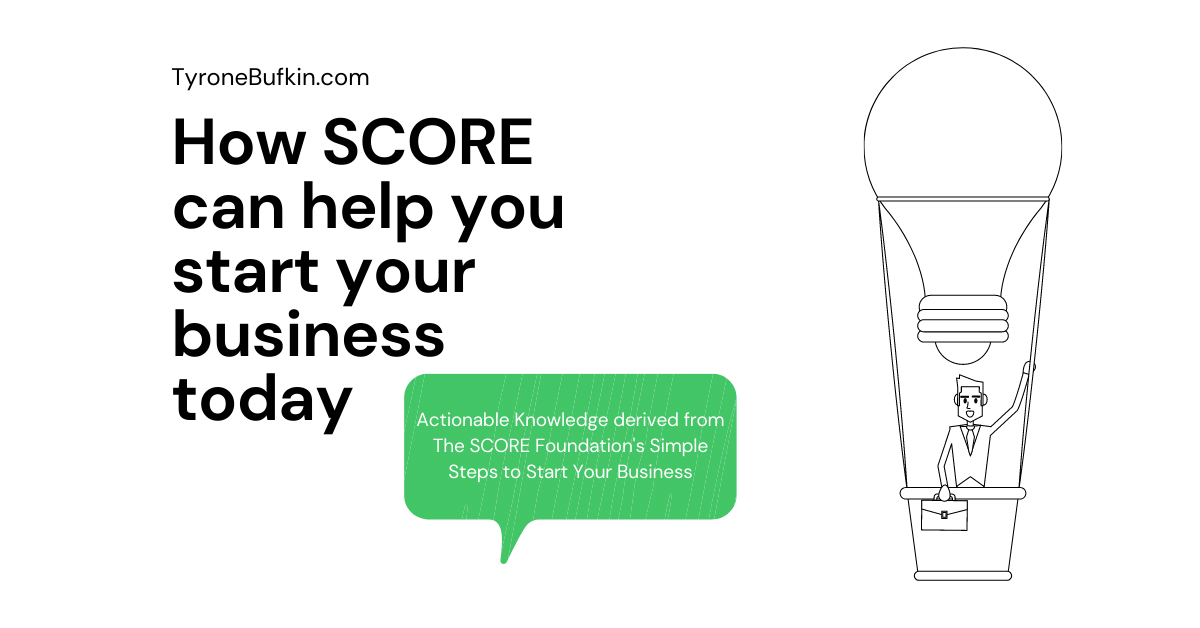THE FIDUCIARY ACTIONABLE KNOWLEDGE IN THIS POST MAY CONTAIN AFFILIATE LINKS. WE GET A COMMISSION, AT NO COST TO YOU, IF YOU DECIDE TO CLICK THROUGH CERTAIN LINKS. WE ONLY RECOMMEND PRODUCTS OR ORGANIZATIONS THAT WE BELIEVE WILL PROVIDE YOU WITH REAL RESULTS. THE INFOMATION IN THIS POST MAY HAVE BE DERIVED FROM THE SOURCES FOUND IN THE 'WORKS CITED' SECTION AT THE BOTTOM OF THE PAGE. PLEASE READ OUR DISCLOSURE PAGE FOR MORE INFO.

Do you dream of starting a big business, but haven't taken the first step? Every small business starts with a dream, but, it takes more than ideas to achieve your goals. Turn your dream into reality by using following these simple steps for starting your business. SCORE Association is a nationwide non-profit organization full of amazing volunteers and mentors who have helped entrepreneurs navigate through all stages of their businesses, especially through difficult times.
I know you are just as busy as I am so I've organized the information derived from SCORE's Simple Steps for Starting Your Business into three sections; The outcome and actions to achieve it, A condensed chapter by chapter summary, and finally my full summary.
Outcome: How to transform a business idea into a operating business.

List of Action Items
- Let go of myths and accept the realities of entrepreneurship
- Assess your skills, experience, and personal finances
- Explore and choose a startup method
- Decide the roles you’ll play as a business owner and the ones you must delegate
- Discuss your legal options with a lawyer and accountant
- Draft a well-written business plan
- Define the market need of your Idea
- Complete market research
- Research your competitors
- Price your product or service
- Create your brand
- Develop your marketing plan
- Choose your marketing platform(s)
- Complete your financial planning
- Record your financial statements
- Understand what your financial statements are saying about your business
- Make the decision to start your business
Condensed Chapter by Chapter Summary
Let go of myths and accept the realities of entrepreneurship; The truth about business ownership is that you will work long hours, there is always competition, you still pay some taxes, your clients become your many bosses, and you will spend significant time on difficult and boring tasks (Section One, Part One).
So you have a good business idea, but do you have the traits required to be successful? It is important to assess your skills, experience, and personal finances to determine if starting a business is the right thing for you (Section One, Part Two).
Before you get into business, it is best to explore the pros and cons of the various options to find the best one for you. It is most common for entrepreneurs to start a new business from scratch which could be a home-based business, non-profit, or online business but you could also buy an existing business or a franchise (Section One, Part Three).

You must understand the many components of business ownership; the roles you’ll play as a business owner and the ones you must delegate. Your business will not be able to run smoothly if you are trying to everything (Section One, Part Four).

Always discuss your legal options with a lawyer and accountant before making a decision on the nuts and bolts of launching a new business. You must weigh the pros and cons and choose a legal business structure of sole proprietorship, partnership, 'C' Corporation, 'S' Corporation, or LLC. Every business may also be subject to registration in every state or country in which they operate, compile with labor laws & IRS guidelines, and purchasing business insurance (Section One, Part Five).
The basics of a well-written business plan should include a brief but informative executive summary, a description of how your business does what your business does, detailed financial forecasts, and supporting and evidentiary data backing up your information. Creating a business plan can be used to get financing, objectivity, and a growth path. Next, you will want to write a vision statement proclaiming your business purpose, products or services, and values (Section One, Part Six).
Fine-tuning your business concept means defining the market need, your personal background, researching your industry, and considering your target market. The success of your Idea depends on if it fills a need, your ability to sell it to your defined target market, and the life cycle of your industry, (Section Two, Part One).
If you hope to succeed in business you must do market research. Take the steps to identify your customer's channel position, geographic location, customer demographic, market size, and market penetration (Section Two, Part Two).

Doing competitive research to know what your competitors are up to will help you make the best business decisions. Complete detailed competitor research into their business model, size, location, profitability, market strategy, features, benefits, price, efficiency, suppliers, and customers. Don't be afraid to do some undercover investigating to find information as close to the source as you can (Section Two, Part Three).
Pricing your product or service properly is an ongoing effort of understanding your distribution channels, markup cost, discounts, target market, cost of goods sold, customer demand, competitors pricing, profitability, and total cost of running the business (Section Two, Part Four).
Creating your brand, what your business is known for, is based on all the elements that make your product or service stand out from any competitor and should be shared in a one-paragraph marketing message to every potential customer (Section Three, Part One).

Developing your marketing plan will detail how you will communicate your marketing message to your target market including your product or service differentiator, marketing communication method, and your marketing strategy (Section Three, Part Two).
Marketing methods to consider are marketing collateral, traditional advertising, public relations, your business website, local search, email marketing, online advertising, and social media sites such as LinkedIn, Facebook, Twitter, YouTube, Pinterest, and Instagram (Section Three, Part Three).

Financial planning is essential to a startup business because it helps you forecast how much startup fund you need, guide future business decisions, communicate with stakeholders, and understand financial risks & rewards. Your financial plan should initially break down the first couple of years and periodically update your sales, costs, profits, and assets (Section Four, Part One).
Understanding and using the following financial statements are critically important to the success or failure of your business; income statement, balance sheet, cash flow statement, breakeven analysis, and benchmarking. An income statement shows your profit and loss, a balance sheet provides a snapshot of your assets, liabilities, and owner's equity, the cash flow statement breaks down the flow of cash in and out of the business, breakeven analysis reveals when your gross margin equals your fixed operating cost, and benchmarking means comparing your financials to similar companies or industry norms (Section Four, Part Two).
Before you start your search for capital to finance your business, you need to have accurate financial records and a clear understanding of your financial statements. Your financial understanding should include monthly financial statements, ratio analysis, accounts receivable & payable analysis, comparative benchmarks, and a profit & loss analysis. Once you know your numbers, you can now seek financing using your own financial commitment, your personal and business credit, owner's equity, or collateral (Section Four, Part Three).

In order to make a decision to launch your business, ask yourself if you need additional research if you need to fine-tune your business idea some more if you need to adjust your business concept. No matter what stage of your decision you are in, reach out for help from experienced mentors and organizations such as SCORE (Section Five).
My first businesses were started with no research or assistance and all but one ultimately failed. It was only when I took the time to do my homework and follow proven strategies that I was rewarded with a successful and profitable trend. My advice to you always is willing to learn more even in the areas in which you think you are an expert.

Simple Steps for Starting Your Business is more than just a guide to business ownership. It’s really a blueprint for helping make your dreams a reality. Complete as many steps as it takes for you to feel ready to move forward and tackle this challenge. If you are not yet ready, continue to fill in the gaps that bring your closer to starting your business. For additional and more detailed information on these simple steps continue reading below.
Section One, Part One
It is important to know what it really means to be an entrepreneur instead of expecting common myths to come true. While you may think you won't have to work hard or put in long hours if fact entrepreneurs work far longers hours than employees do. The difference would be that you get to build something of your own. No matter how unique you believe your product or service is, you will always have competitors of some form. You do get to deduct the majority of your expenses but you still have to pay taxes on your net income. If you are starting a business in order to relieve yourself of a boss, then think again because you will have many "bosses" called clients and customers. Business owners do not get to just do what they want because a lot of your time will be spent on tasks that you find difficult or boring. One was the biggest myths is that the majority of small businesses fail and it is true that about 50% of businesses survive after five years, however, Proper planning and hard work can protect you from failure.
Just because you have a great idea does not mean you have to start your own business. If debunking these myths scares you then perhaps you should save yourself the stress and find a job that would allow you to implement your idea. I started and failed at multiple businesses before gaining a small level of success. The biggest myth I believed was that I wouldn't have a boss if I start a business. So when a client would make demands I didn't even want to entertain then I would lose the client. I found out the hard way that a business with no clients, means no money; no money means no business. I will add that your 'bosses' can include more than clients, at times you will need to answer to investors, partners, employees, vendors, and competitors.
Section One, Part Two
You may have a good idea but do you have the characteristics required to succeed in business? While some of the following traits can be learned, others are external and harder to control. These factors include industry-specific education, strong work ethic, effective time management skills, ability to multitask, management skills, willingness to ask for help, able to take advice from others, self-motivated, resourceful, responsible, organized, persistent, decisive, good health, and a supportive family. On top of these personal traits, almost all startups will need financial support from their own personal finances first. you will need to know how to limit your personal expenses to cover the start-up cost of your business.
Sometimes it is better to spend time working on yourself before you work on a business. In a small business, the owner is the primary reason it will fail or succeed. I started a financial services business before developing the skill of self-discipline. Ultimately, I spent a ton of time playing video games and telling everyone I was going to be rich. While I learned a lot about finance, I learned more about what I needed to fix in order to be a successful entrepreneur.
Section One, Part Three
There are many different methods of getting into the business and each one has its advantages and disadvantages.
- When starting a new business you have a fresh image with the ability to choose your own location, name, logo, and business relationships. You can explore new markets and directions. However, you take on a bigger risk because you have no existing customer base to build on, no track record, and limited financing.
- Buying an existing business usually comes with an established customer base, location, and supplier relationships. Your business would be a known entity with a profitable track record you can review and name recognition that may make it easier to obtain financing. However, you may overlook hidden problems such as outstanding debts, misrepresentations of profitability, a bad reputation, obsolete inventory, employees loyal to the previous owners, and new ownership issues.
- A franchisor usually provides you with a proven system with well-known products and services, marketing and sales power, training, guidance, and a network of other franchises. However, you won't have much freedom, you will pay ongoing fees, may be unable to exit the business, and any franchisor problems are your problems too.
- Starting a Home-based business is usually convenient, less expensive, allowed to have a flexible schedule, and has crossover assets that can be tax-deductible. however, your home may have zoning or deed restrictions, working from home can be isolating, you may have difficulties obtaining financing, you must endure more distractions, and home-based businesses are often subject to IRS scrutiny.
- A Non-profit organization may qualify for grants and provide liability protection, salaries, and consulting wages to directors and employees. However, A nonprofit must focus on educational or charitable purposes, cannot profit the founder because all profits must remain within the organization, and must qualify for 501(c)(3) status.
- An online business has lower startup costs, unlimited prospects, 24/7 access for your customers, and you can do business anywhere and anytime. However, few webpage visitors will make a purchase, there is a lot of competition, visitors usually have high expectations and less tolerance for problems.
The best way to get into business is the path of least resistance for you. Do your homework and determine which method provides the fast route to success. You can always pivot should you need later. Most of my businesses were started from scratch, the one existing business I've invested in was a fundamentally different experience to help grow. I may have explored an alternate method of starting my business if I knew about them.
Section One, Part Four
Unlike the majority of employees, entrepreneurs wear many hats and are responsible for making sure all the components of your business run smoothly. You may choose the role of the CEO or president but you will also be in charge of administration, accounting, human resources, marketing, sales, customer service, production, fulfillment, information technology, physical plant, and more. Even if you are skilled in all roles required of a business it would be impossible for you to handle them all. You need to identify which roles you will focus on and which you will delegate. In choosing, consider your strengths, weaknesses, ability to improve current skills, and the things that must be outsourced.
This means there is no such thing as a solo entrepreneur, you will need to build relationships that can help run your business. You must learn to trust the right people to work with you to accomplish your business goals. I spent a long time trying to do everything myself and I've barely learned my lesson. I find it hard to give up enough control to delegate required tasks until I absolutely have to. Still, if I hope to continue my path to success I must apply this advice.
Section One, Part Five
There are three primary considerations when launching your business; Choosing a legal business structure, understanding government rules and regulations affecting your business, and buying business insurance. You have several options for the legal structure of your business including sole proprietorship, partnership, 'C' Corporation, 'S' Corporation, or LLC. Rules and regulations that may affect your business include registration, licenses, zoning approval, labor & immigration laws, IRS & social security withholding. Your business, sooner rather than later, may need insurance for property, injury, vehicles, and employees.
A sole proprietorship means you personally own, control, and operate your business. Your business earnings are taxed as personal income, you are personally liable for any claims against your business, and getting financing is often more difficult. Many businesses start as a sole proprietorship then switch to a more complex structure.
In a partnership, both general and limited partners manage the business in predetermined capacities, take personal responsibility for debts, and report profit and loss on their personal tax returns.
Incorporating a conventional corporation will protect you from the company's debts and claims against it and allows you to raise money by selling stock. Corporations are strictly regulated and are taxed twice - the corporation pays income tax and the shareholders pay taxes on any dividends.
A subchapter corporation protects owners against liability, doesn't pay federal income taxes, and profits & losses are reported on shareholders' individual tax returns. However, complying with regulations can be costly, time-consuming, restricted to a limited amount of shareholders, and limited when raising capital.
A limited liability company offers protection like a corporation but without double taxation, because earning and losses are reported on the owners' personal taxes with no limit on the number of members.
All businesses need to be registered in every state or country in which they operate using a physical address and may need a state, county, or municipal license.
Hiring employees requires you to comply with state and federal labor and immigration laws concerning work hours, breaks, safety, hiring, and many other factors.
Every business, even those with one person, must follow the IRS state and local guidelines for mandatory withholdings, payroll services, and an independent bank account.
All your hard work could disappear if don't consult a business insurance broker to protect yourself from loss to your buildings & their contents, bodily injury to customers, vehicle damage, and injury to employees on the job including life and health insurance.
While legal matters are probably the least exciting part of starting your business, it one of the most important tasks you must complete to ensure the survival of your business and its ability to grow. LLCs are my favorite legal structure so far but I have not controlled a corporation as of yet. I enjoy the flexibility and limited restrictions while still having legal protection. Although I know as my company grows I will need to incorporate them to continue the proper level of legal protection.
Section One, Part Six
A well-written business plan can be used to get financing, give you an objective view of your business, clarifies your ideas, and as a foundation for business growth. Every basic business plan includes a table of contents, executive summary, business description, financial forecasts, and supporting data.
The executive summary is an overview of the business plan briefly explaining the company's inception, the business idea, the experience of the management team, how the company plans to achieve success, how much money from investors or loans you need, how you plan to pay it back with your revenue model, and your return on investment. Although the executive summary is the first part of the business plan, it should be written after you have thought through all the other elements of your plan.
The business description explains what your business does and how it will operate including an assessment of the products or services, the market need, business location, how you will beat your competition, your key management & personnel, and how you will use the funds if you are seeking financing.
Your financial forecasts need to detail where the money to start your business will come from, how it will be spent, and project its growth using a capital equipment list, income statement, balance sheet, cash flow statement, and a break-even calculation.
Finally in a supporting data section, provide evidence of your due diligence by backing up your information with facts and sources.
Your next step is to write a vision statement that contains the overall purpose of your business, a short description of your products or services, and the values your company will live by.
You have heard it said, those who fail to plan, plan to fail. This is evident in the millions of small businesses that fail and never created a business plan for success. While it may take some time and it's not the most exciting part of starting a business, it is a critical first step.
I have started my early businesses with no business plan and all the latest startups have a business map. The biggest difference is my ability to deliver on business promises. A business map forces me to maintain and defend the expectations of myself, my employees, and my clients. When I make a business promise, it is based on a detailed step-by-step path to success easily shared with everyone involved.
Section Two, Part One
Use these tools to research your industry:
- The North American Industry Classification System (NAICS) is the standard system federal agencies use to classify businesses. Search it online or go to www.census.gov/eos/www/naics/ to find your industry description.
- Trade associations also have valuable industry information. Search for associations online or consult the National Trade and Professional Associations (NTPA) Directory, available at libraries or online at www.associationexecs.com.
- Risk Management Association (RMA) Annual Statement Studies, available at libraries or online at www.rmahq.org, provide benchmark financial ratios for businesses in over 370 industries.
In order to fine-tune your business idea or concept, you should define a market need, examine your personal background, research your industry, and consider your target market.
A good business idea fills a need better than anything that exists in the market with its features, benefits, competitive advantage, or method of producing, delivering, and marketing. Examine your personal life and work experience, do you have any experience related to your idea, how risk-tolerant are you comfortable with, how can you modify your idea to fit your experience and risk tolerance? Also, do you have the passion to convincingly sell this idea to customers, investors, and partners? When researching your industry you will want to know how fast a business can be expected to grow based on growth trends, what the average margins are, what future and current trends are affecting the industry, and what part of the life cycle the industry is in; Rapid growth, Maturity, Reinvention, Slow decline, or Rapid decline.
Do not try to be all things to all people, define your target market by determining
- Are you selling to retailers, wholesalers, consumers, or other businesses?
- How big is your potential market?
- What is your customer's ability to pay for your product? Are they upscale or bargain hunters?
- What are the demographics of your customers including location, company size, sex, age, marital status, and education level?
- Does their lifestyle include urban or rural activities during work, leisure, or personal time?
- What are their spending habits? Where do they shop? How do they buy?
Other key factors when assessing your business idea are to identify your competition, suppliers, your product or service life expectancy, legal. and environmental factors. If you attempt to bring your idea to the market without doing this part of your due diligence you inevitably face failure. The same going with doing this exercise once and never again. Your customer is always changing and the only way to continue success is to change with them. The earlier businesses I mentioned were launched without any review of the market and I spent a lot of wasted time trying to figure out why my income was wildly inconsistent. Some months I would make very good money and other months I would make no income at all. it was only after I complete my industry research did I figure out that I was approaching my target market incorrectly. If I had learned this lesson sooner, I may have saved myself from years of struggle.
Section Two, Part Two
Market research is going beyond identifying your target audience to learn about how they buy, what matters to them, and where and how they spend their time. Carefully research the cost and potential profit of each channel position, Gather information about the geographic location you will be doing business, What percentage of your customer's income does to your type of product or service, identify the specific niche of your customer's gender, age, race, and marital status, explore marketing tactics work best with your customers based on market size, and finally determine how much of the market you believe you can capture.
When doing your market research you should also consider your product or service, does it fully solve a problem for the customer? How should you change the product or service based on your market research; or should you change your ideal client?
I am relatively new to traditional market research, I have used a form of market research that only works with a small nimble company; Feedback. Everything and anything that happens concerning my business is simply feedback. If my product or service is not selling enough they may be feedback that my client's needs are shifting. If I get multiple bad reviews then that is the feedback that something is wrong with my people or process. However, this is a completely reactive method of managing business risk whereas completely marketing research would allow me to solve problems before they are problems. I believe a business should be doing both.
Where can you get data about customer groups?
- Trade associations: Trade groups typically maintain data about market trends. Search for trade associations online.
- Reference librarians: A good business reference librarian can be immensely helpful in finding what you’re looking for.
- Government websites: You’ll find a wealth of information at www.sba.gov, www.bls.gov, www.nber.org,
http://factfinder2.census.gov, and www.fedstats.gov. - Focus groups: Get a group that represents your target market—whether that’s college students or moms—together for a short focus group.
- Surveys: Online tools like www.SurveyMonkey.com and www.SurveyGizmo.com offer free options for conducting surveys to ask potential customers questions; www.ConstantContact.com is competitively priced fee-based option.
What factors are shaping your customers’ behavior? The following sources will help you keep on
top of trends.
- Newspapers: Since trends typically start in big cities and trickle down to other areas, read the leading newspapers from urban areas, such as The New York Times.
- Periodicals: Read the magazines your target market reads—whether that’s Road & Track or Vogue—to keep up with what matters to them.
- Television: Popular shows are often good indicators of consumer trends. For example, the growth of cooking shows in the past decade has been matched by consumer spending on gourmet foods, home entertaining, and tools for home cooking.
- Internet: Set up Google Alerts for topics you’re interested in, or visit Google Trends (www.google.com/trends) to see what the most popular searches are at any given time.
Section Two, Part Three
You need to know what your competition is doing when positioning your product or service. In researching your competition uncover their business model, the size of their company, their selling locations, their average profit margin, how they position themselves with their marketing strategy, how the features and benefits of their product or service compare to yours, What their pricing structure is, and how they are staffing their company. You can't learn everything you need to know from a competitor without some sleuthing. While you can get good information from their website and social media, you should also sign up for their newsletters, become followers of their social media platforms, and even pretend to be a customer. When you are contacting suppliers to price the raw material of your products and service, see if you can get information on your competitor's pricing. Take note of what your competitor's customers are saying about them online. Find out general information about industry benchmarks, trends, and averages from trade associations. Set up google alerts on your competitors to receive news, growth patterns, and future plans.
Knowing what is happening with your competition helps in every area of your business. You get an idea of what has worked and what has not worked with similar products and services, marketing campaigning, pricing, and more. Competitive research has allowed me to operate my businesses with confidence. The biggest advantage I have received is pricing. When a potential client tells me that they can get this down the street for less, I can detail what they will get by going to our competitor and why staying with us is better.
Section Two, Part Four
Smart pricing starts with understanding the market price made of up the average price of competitors and the general price value in the marketplace. Some pricing considerations include the cost of making your product or service, whether you sell directly to consumers or not, the markup you need to put on your product or service, the discounts you will offer including bundling products and services, the price your target market is comfortable paying, and the promotional pricing you will offer. Pricing is an ongoing effort, After you set your initial prices you will need to tinker with it in order to satisfy sales goals, profit needs, changing market conditions, customer demand, the value required, and your business cost.
Channels are how products and services are distributed to the customer. Below are common channels businesses use:
- A direct sale to business (b2b): You may sell products or services directly to businesses.
- A direct sale to consumer (b2c): You may sell products or services directly to individuals.
- Sale to a distributor who sells to the retailer: If you manufacture or import a product, you may sell it to an agent or middleman, who then sells it to retail outlets.
- Internet sales: You may sell to either businesses or consumers online (e-commerce).
- Associate or affiliate networks: You may sell your product through a network of associates (offline) or affiliates (online) who keep part of the profits in return for facilitating the sale.
There are so many factors that create the uniquely perfect pricing of your products or services that It is best to put all the research you can into your initial pricing but be prepared to pivot as needs especially at the beginning of your business. I have worked with a lot of startups and I have found the clients of a new start-up are more comfortable with pricing changes than an established business; assuming they understand the reason for the pricing change. None of this matters until you actually get into the market so even if you are not completely certain about the pricing you should just set an initial price and listen for feedback. Established companies must create a transitional plan for pricing changes that limits the loss of current clients but achieves the goal.
Section Three, Part One
Your brand is the image of your business and what people think when they hear your business name. You need to create your brand and focus your marketing, around what you want your business to be known for. Your brand will largely be based on what makes your product and service stand out including special benefits, unique features, limits and liabilities, production and delivery methods, suppliers, and intellectual property. Your marketing message sums up all the elements of your brand in one paragraph to be used in almost every method of communication to potential customers.
Your brand is one of the most important reasons a potential customer will choose you over your competitor. In order to protect your brand, your must fulfill your brand promise through your products and services. Creating a brand forces you to narrow your ideal client because you will not be able to please everyone or properly fulfill a general brand promise. So it is my opinion that as a startup, your focus should be on developing your product and service before finalizing your brand. Your branding message will need to change at the same rate as your product and services.
Section Three, Part Two
A market plan lays out your marketing message and how you plan to communicate it and should include your target market, how your product or service is different and better than competitors, the need it fills, the problem it solves, the marketing communication methods you will use, and finally your marketing strategy. Common marketing communication methods are advertising & public relations ( radio, tv, newspaper, magazine, direct mail, yellow pages, online, blogs), Collateral (Business cards, brochures, stationery, flyers), Internet (Website, email, search engine marketing, social media marketing, content marketing), product samples, special offers, presentation materials, and signage. Your marketing strategy should include your marketing message, channel choice/sales approach (Direct sales, internet sales, etc), one-time cost, and periodic expenses
Match your marketing method to your target market. The effectiveness of marketing methods will vary by target markets, sales channels, and types of business. When planning your marketing mix, take into account who you are selling to and how you sell.
- Business to Business (B2B) for a product or service
- Business to Consumer (B2C) for a product or service
- Sales channel (direct sales, Internet sales, etc.)
Now that you have done the hard work of figuring out your business it's time to share it with your ideal client. If no one knows who you are, you will never grow your business. Try not to over-complicate your marketing strategy. It is simply a process of elimination to figure out the best method of getting the word out about your business. As your target market, ideal client, and products or services change so will your marketing strategy.
Section Three, Part Three
- Websites such as Inkzoo (www.inkzoo.com), Vistaprint (www.vistaprint.com), and 99Designs (http://99designs.com) can help you develop marketing collateral affordably.
- if you do want to create and distribute press releases, websites such as PRNewswire (www.prnewswire.com), PRWeb (www.prweb.com) and PRLog (www.prlog.org) offer tools, tips, and resources.
- Some popular options to investigate include Verisign (www.verisign.com), GoDaddy (www.godaddy.com), Web.com (www.web.com), Homestead (www.homestead.com), Weebly (www.weebly.com) and Squarespace (www.squarespace.com).
- Using an email marketing service provider such as Constant Contact (www.constantcontact.com), Campaigner (www.campaigner.com) or Benchmark E-Mail (www.benchmarkemail.com) can simplify email marketing. Your website hosting service may also provide email marketing assistance.
- campaign: Just use Google Analytics (www.google.com/analytics) or Bing Analytics (www.bing.com/toolbox/webmaster), free tools that show you where visitors to your website come from, what they do on your website, and how many of them contact or buy from you.
The most popular marketing tactics include:
- Marketing collateral, which every business will need some type of, includes business cards, brochures, flyers, trade show banners, and in-store signage.
- Print ads in newspapers, magazines, or circulars that your target market are most likely to read
- Direct mail postcards, sales letters, and brochures to prospective customers using a good mailing list and/or service providers.
- Broadcast on radio or tv to your local customers using data to choose the best time slots.
- Use public relations to let the world know about your business with formal or informal press releases to reporters, editors, broadcasters, influential bloggers.
- Your business website, even if you don't plan to sell anything online, needs to provide credibility, information, and perspective to your potential customers. Use Search Engine Optimization (SEO)
- Local search directories such as Google, Bing, and Local to claim a free business listing to help internet users find your online.
- Use email marketing to send your customers newsletters, marketing emails, special offers, and upcoming events. Be sure to abide by CAN-SPAM laws, which you can find at http://www.ftc.gov/spam.
- Advertise online using pay-per-click or banner ads on Google, Bing, or other search directories.
- Use general business-to-business networking on LinkedIn to find, research, and introduce yourself to potential customers, partners, suppliers, and even new employees.
- Facebook is more informal and works best for consumer-focused businesses with a 'fan' base and requires posts on a regular basis to remain relevant.
- Use Twitter to offer something of value in short messages to your followers and those following you.
- Use YouTube to create and share videos featuring fun and interesting product demonstrations, how-to instructions, behind-the-scenes tours, etc.
- Pinterest is a virtual bulletin board for visually-oriented products or services driving traffic back to your website.
- Instagram is a photo-sharing social media site popular with users aged 18 to 24 and works best with creative image post that tells a visual story about your company.
Social Media can seem overwhelming but to maximize your efforts you should link your social media profiles to your business' website, don't be too promotional, be personal, pick one and do it well, use tools to streamline your efforts, and save time, and track defined goals.
You should already know how important marketing is for your business because it can maintain or grow your revenue. However, running the required number of marketing platforms and their campaigns is expensive, time-consuming, and has no guarantee of continued success. In my opinion, every business no matter how small needs at least one person whose only job is marketing because it is a full work week of responsibility. If you are trying to run your business and your marketing you will run of out time on one or both of these tasks.
Section Four, Part One
The next step is to use financial planning to figure out how much money you will need to start and run your business, as a guide for future business decisions & results communicate with stakeholders about business finance, have an understanding of financial risk and reward, sales, costs, profits, and assets for at least the first year. The components of your financial plan include required startup funds, salaries & wages, fixed operating expenses, projected sales forecast, and cash receipts & disbursements.
When calculating your startup funds, some factors to consider are how much you need to get your business up and running, what will it be used for, what are your expected sources of capital, How much will be financed from you, and how many other partners. Also consider the cost of equipment, inventory, insurance, legal fees, and working capital for the first 18 months.
Calculate the wages for employees and owners including taxes and benefits.
Fixed operating expenses include administrative, insurance, rent, utilities, sale commissions, advertising, taxes, and license expenses.
Project your sales by figuring out in what units your products or services will be sold and gross profit margin. The different types of units are measured in products, services, or hours; a single business may use multiple types of units. Once you have your average unit sale, you can then calculate your direct cost per unit and your price per unit. The gross profit margin is the dollar amount of your sales minus the direct cost of those sales. Direct costs are those that vary based on volume and indirect costs (overhead cost) are fixed. Figuring out your gross profit margin and industry norms helps you estimate the cost and price of what you're selling.
You will need to project when you will receive payments based on industry norms; the most common payment terms are 0-30 days, 31-60 days, and 60 or more days. Sometimes you can speed up payments by offering discounts or credit payments.
A business, even if it has survived for years, can fail within hours if the financials are not carefully managed. Your financial statements are the heartbeat of your business and while it may be boring, difficult, frustrating, and paining to manage at times it is the most important duty of a successful entrepreneur. Before I devoted myself to business, I hated math and numbers. I used to believe that I can just hire someone to handle the financials but that's not how business works. While you may be able to hire someone to handle the financials on a regular basis, you still need the understanding to use your financial information to maintain, protect, and grow your business.
Section Four, Part Two
Sources of financial ratios include:
- BizStats (www.BizStats.com)
- D&B (www.dnb.com)
- Risk Management Association (RMA) Annual Statement Studies (available at libraries or online at www.rmahq.org)
There are three financial statements that create a current and future trajectory picture of any business; Income statement, balance sheet, and cash flow statement. In addition, the two other key financial tools that can help assess your business are break-even analysis and bench-marking.
The Income statement shows how much profit and loss is generated. It is prepared monthly or quarterly and filed annually as part of the business's tax return. The top line shows incoming revenue and subtracted from that is the cost of goods sold, foretasted operating expenses. What remains is operating income which is then modified to account for any nonoperational income or expenses. The final balance is called income before taxes or profit; This is the business's taxable income.
The balance sheet gives you a snapshot of your assets (What is owned), your liabilities (what is owed), and your equity or net worth at a single point in time. Assets minus liabilities must equal the owner's equity (the proportion of asset value that represents money invested by the business owners). Current or short-term assets and liabilities will be used up or changed into cash within a year and fixed or long-term assets & debts will take more than one year to pay off.
The cash flow statement details collections and payments that come into and out of your business and whether or not you have the funds to run and grow the business. It does not show non-cash items but rather cash outlays not shown in the income statement. The cash flow statement should be used each month to determine whether your financial projections are accurate and that you are bringing in more cash than you are spending including lines of credit.
The break-even is the point at which your gross margin equals your fixed operating cost using the formula; total operating expenses divided by gross margin percent. Most startups expect to reach the break-even point in the first 6 to 18 months of operations.
Bench-marking means comparing your company's financial information to the same information from similar companies or industry norms as a way to test the feasibility of your financial plan.
Learning how to read these financial statements, even if you are not responsible for preparing them, will provide you with the vital knowledge you need to run your company. Said best by Marcus Lemonis, "If you don't know your numbers, you don't know your business". It took me some time, a lot of effort, and the realization that the learning is ongoing but now I can read a financial statement and see a company like looking at matrix code. Basically, I can look at financials to judge a business's health trend and future. Numbers don't lie, a business owner can give a passionate speech about how much money their business will make but it must also make sense on the financial statements
Section Four, Part Three
Performing regular financial analysis and keeping accurate financial record-keeping are essential steps in obtaining financing for your business. Your financial analysis should include reviewing monthly financial statements, ratio analysis, accounts receivable & payable analysis, comparative benchmarks, and profit & loss analysis. Depending on your industry there may be other key measurements to track such as inventory turnover, and days of outstanding payables & receivables. Whether or not you are seeking financing, you must keep your financial records accurate by entering facts, research, and future projection into one of the many software programs available.
To get a bank loan, lenders will look for good credit, a feasible business plan, adequate owner equity, sufficient collateral, management expertise, and the owner's commitment. Most bank loan applications will require an introductory cover letter, a summary of financial needs, the last 3 years of personal financial statements & tax returns, projected 12 months of cash flow, personal and business collateral, owner's and manager's resumes, any legal claims against the owner or business, and insurance policies.
The six C's of credit are character, capacity, capital, collateral, conditions, and cash flow. Character includes a person's trustworthiness, credit history, integrity, references, experience, and impression. Capacity is the borrower's ability to repay the amount borrowed, how soon you can generate positive cash flow and reach a profit, and how large & how long the profit can be sustained. Capital is the money you have personally invested and your ability to save money & accumulate growth. Collateral includes the secondary source of repayment such as a third party guarantee, tangible assets, property, equipment, account receivable, inventory. Conditions are the terms of the loan, intended purpose, amount requested, length of the loan, and local economic climate of the industry & business. Cash flow shows where the money to repay the debt will come from and how the loan proceeds will be used. As a rule of thumb, banks want to see annual “free cash flow” equal to 1.3 times annual debt service requirements. (Debt service means principal plus interest payments.) Because cash flow forecasts are uncertain, banks prefer a cushion of one-third more than projected debt service requirements.
It is vitally important you know for certain how much money you need and why before seeking outside funding for your business. If you do not, then you are more vulnerable to be taken advantage of by a lender. It very well could be the reason your business does not succeed. What I have always done, and wholeheartedly suggest to you, is to attempt to personally finance your startup as long as you can before bringing in a financial partner. Doing this will put you in a better position of negotiation and give you a much clearer picture of your financial needs. Who knows, you may discover that while it road was harder you didn't need to share the rewards with anyone else.
Let’s take a closer look at different ways to fund your business using those two types of financing.
Traditional forms of financing
- Owner’s equity investment: As a rule of thumb, 25 to 30 percent of the business’s capital needs should be funded by its owner/s. This can come from savings, cashing in investments, or the cash surrender value of an insurance policy.
- Partners: If you don’t have adequate capital yourself, consider taking on a business partner who can put money into your startup.
- Friends and family: This can be in the form of debt (a loan) or equity (giving the friend or family member ownership in the business in return for their investment).
- Loans: These could be from banks or credit unions and could include home equity loans.
- Credit cards: If you pay off the balance in full every month, credit cards can work, but if you don’t, this can become expensive very quickly.
- Sale of capital stock: Depending on the legal form of your business, you may be able to raise capital by selling stock. Be aware this means giving up some ownership.
- Grants: For most for-profit businesses, grants are not available. If you are starting a nonprofit organization, however, grants may be an option.
- Sba guaranteed loans: These loans are made by banks, but a percentage of the loan is guaranteed by the Small Business Administration, making banks more willing to take a risk on your business.
- Department of community and economic development: Local economic development programs may offer financing assistance.
- Department of agriculture and rural development service: If you are located in a rural area or starting an agricultural-related business, there may be special loan programs available to help you. The SBA also has loans targeting rural entrepreneurs.
- Angel investors: Angels are individual investors, often former entrepreneurs, who invest in promising companies. They may form angel groups and invest together.
- Venture capitalists: Venture capital companies invest in companies that have the potential for high growth and a rapid return on investment. They often focus on tech companies and seek large investment opportunities with multiple rounds of funding.
- Crowdfunding: Also known as crowd financing and crowdsourced capital, crowdfunding is an alternative method for raising financing for a business idea that gives business owners access to a broad swath of potentially interested investors via the Internet.
- A donation, charity, social or rewards-based crowdfunding allows individuals to donate money to a business startup idea in return for rewards such as early access to products or services, limited-edition products, or premiums. In the case of nonprofits, funds are used to support a cause. Websites such as Kiva (www.kiva.org), Kickstarter (www.kickstarter.com), and IndieGoGo (www.indiegogo.com) are portals for these kinds of campaigns.
- Credit-based crowdfunding, also known as peer-to-peer lending, offers opportunities for a “crowd” of supporters to connect and lend working capital. Benefits can include lower interest rates and creative repayment terms. Websites such as Prosper.com (www.prosper.com) or Lending Club (www.lendingclub.com) facilitate this kind of crowdfunding.
- Equity-based or investing crowdfunding allows entrepreneurs to source seed capital from a number of investors, including non-accredited investors, without a public offering. This form of crowdfunding allows new business owners to access a larger number of investors. This form of crowdfunding is undergoing the most scrutiny and is evolving most rapidly. Consult the proper advisors if considering this option.
Financing from the balance sheet
- Accounts receivable financing: Also called factoring, this is a means of obtaining financing based on the value of your accounts receivable.
- Bank line of credit: This is a pre-established amount of credit that you can use as needed. A line of credit can offer more flexibility than a loan and is simpler to obtain. It is typically based on 75 percent of your current accounts receivable or 50 percent of the value of your inventory.
- Equipment leasing: Instead of buying business equipment, consider leasing to conserve cash. Many leasing companies offer to finance.
- Chattel mortgages: In a chattel mortgage, you obtain a loan to buy an item and use the item itself as collateral for the loan.
- Plant improvement loans: You may get a loan to improve your building or facility by putting up the property itself as collateral. The loan will typically be limited to 75 to 80 percent of the property’s market value.
- Conditional sales contract: This allows you to finance the purchase of an item; the vendor still owns the item until you have paid the full amount.
Visit these websites for more information about loans and other types of
financing: Federal government grants: www.grants.gov Sba guaranteed loans: www.sba.gov SCORE: www.score.org
Section Five
In order to make a decision to launch your business, ask yourself if you need additional research if you need to fine-tune your business idea some more if you need to adjust your business concept. No matter what stage of your decision you are in, reach out for help from experienced mentors and organizations such as SCORE.
If you examined yourself and determined that you don't want to handle all that comes with starting a small business, you have other options. You can join up a partner whose job it is to do the things you can't, you can find an entrepreneurial job that fulfills your needs, or scale down your goals. If you are not crazy committed to doing anything and everything it takes to turn your idea into reality, then you may not want to start a business. The job market has changed a lot over the years and employers, including in some of my companies, are looking for people who want some ownership and we are willing to give you some of the benefits you would get as a small business owner; but you would not have to take on all the duties and risk of doing it alone. However, if you want the full freedom, rewards, and risk that comes with small business entrepreneurship then it is time you take the next step.
While these steps are simple, they are not always easy. It is best to take it day by day and do what you can do now. Evaluate your idea, discover the elements, of success, get expert advice and assistance, network, and continue learning.

Works Cited
The Score Foundation "Simple Steps for Starting Your Business" SCORE Association, 2014.



